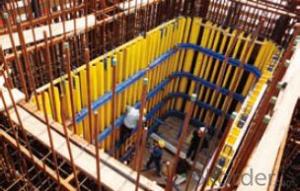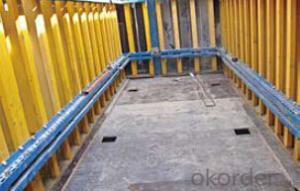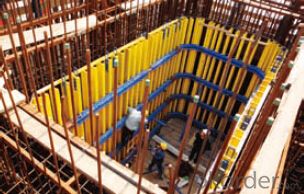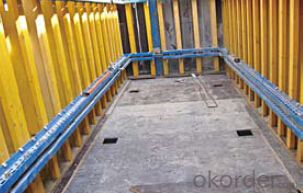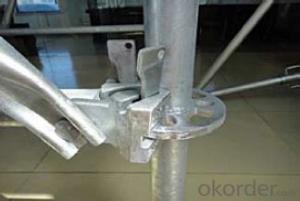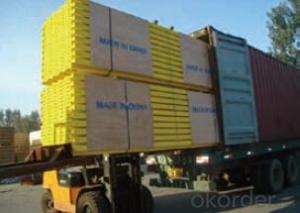Shaft-platform System for Formwork and Scaffolding
- Loading Port:
- Tianjin
- Payment Terms:
- TT OR LC
- Min Order Qty:
- 50 m²
- Supply Capability:
- 1000 m²/month
OKorder Service Pledge
Quality Product, Order Online Tracking, Timely Delivery
OKorder Financial Service
Credit Rating, Credit Services, Credit Purchasing
You Might Also Like
Shaft Platform
As operating platform, the shaft platform is mainly used in the concrete pouring of elevator shaft,
equipment shaft, stair shaft of high-rise building and so on.
Characteristics:
◆ The length of shaft beam is adjustable.
◆ Flexible structure makes lifting easier.
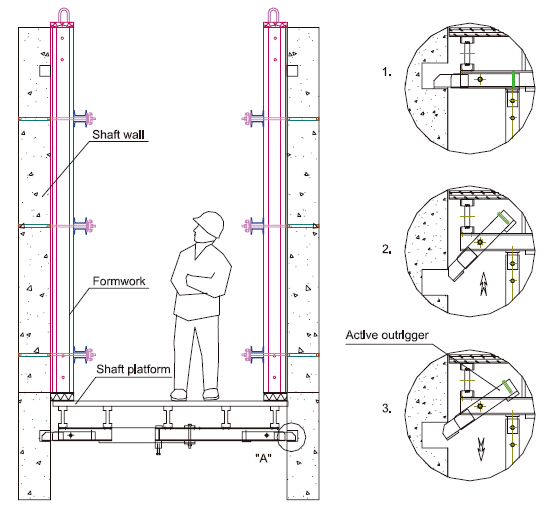
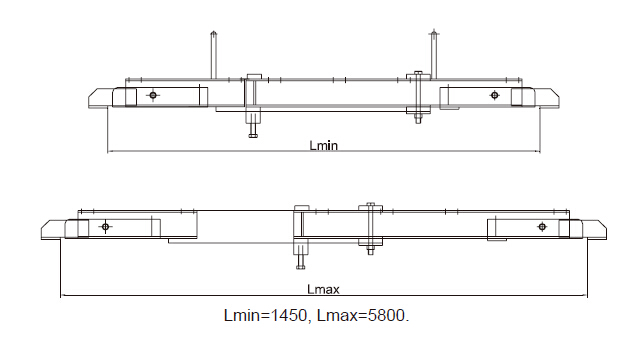
- Q: How does steel formwork perform in seismic zones?
- Steel formwork performs well in seismic zones due to its high strength and ductility. It can withstand the forces and vibrations caused by earthquakes without significant damage. Additionally, steel formwork provides stability and structural integrity during construction, ensuring the safety of the building in seismic events.
- Q: What are the different types of access solutions available for steel formwork?
- There are several different types of access solutions available for steel formwork, depending on the specific requirements of the construction project. Some of the common access solutions include: 1. Ladder Access: This is the most basic and commonly used access solution for steel formwork. Ladders are attached to the formwork structure, allowing workers to climb up and down easily. Ladder access is simple, cost-effective, and suitable for low-rise structures. 2. Stair Access: For taller structures, stair access is a safer and more convenient option. Stairs can be attached to the steel formwork, providing a stable and secure pathway for workers to move between different levels. Stair access is particularly useful in high-rise buildings or projects with multiple levels. 3. Platform Access: Platforms are often used in conjunction with ladders or stairs to provide a wider working area. These platforms can be fixed or movable, allowing workers to access various parts of the steel formwork system easily. Platforms provide a stable and safe working surface, enhancing productivity and safety on the construction site. 4. Scaffold Access: Scaffold systems are commonly used for construction projects and can also be utilized for accessing steel formwork. Scaffold access provides a flexible and adjustable solution, allowing workers to reach different heights and areas of the formwork structure. Scaffold access is particularly useful for complex projects or projects with irregular shapes. 5. Crane Access: In some cases, large steel formwork panels or structures may require the use of cranes for access. Cranes can lift workers to the desired height, providing a quick and efficient access solution. Crane access is often used for heavy-duty formwork systems or projects with large-scale structures. In summary, the different types of access solutions available for steel formwork include ladder access, stair access, platform access, scaffold access, and crane access. The choice of access solution depends on factors such as the height and complexity of the structure, as well as the specific requirements of the construction project.
- Q: Can steel formwork be used for bridge construction?
- Bridge construction can indeed utilize steel formwork. This adaptable and robust material provides the necessary strength and stability throughout the construction process. It is suitable for various types of bridges, including beam bridges, arch bridges, and cable-stayed bridges. Steel formwork brings numerous advantages to bridge construction, such as easy assembly and disassembly, a high capacity for bearing loads, resistance to different weather conditions, and the ability to be reused multiple times. Moreover, steel formwork enables precise shaping and finishing of bridge components, ensuring a final structure of exceptional quality and aesthetic appeal. In summary, steel formwork proves to be a dependable and efficient choice for bridge construction projects.
- Q: Can steel formwork be used for school construction projects?
- Indeed, school construction projects can make use of steel formwork. Steel formwork, being a resilient and versatile construction material, is capable of withstanding the immense loads and pressures encountered within school buildings. It provides a robust and steadfast framework for pouring concrete, thus ensuring the structural integrity of the construction. Furthermore, steel formwork is designed to be reusable, thereby offering a cost-effective option for school construction projects. Its adaptability allows for the creation of various shapes and sizes, catering to the distinct architectural designs typically found in school buildings. Moreover, steel formwork facilitates faster construction times when compared to traditional timber formwork, enabling the swift completion of school projects. In summary, steel formwork represents a fitting and dependable choice for school construction projects.
- Q: Is steel formwork suitable for projects with high formwork reusability?
- Projects that require frequent formwork reuse benefit greatly from using steel formwork. Steel formwork is renowned for its durability and strength, enabling it to endure numerous uses without substantial damage. Its assembly and disassembly are effortless, making it highly efficient for reuse on various projects. Moreover, steel formwork guarantees a polished and uniform concrete structure, delivering exceptional quality results. Although steel formwork may initially have a higher price tag compared to alternative formwork types, its extended lifespan and reusability make it a financially prudent choice for projects demanding frequent formwork reuse.
- Q: How does steel formwork affect the overall constructability of a structure?
- Steel formwork can greatly improve the constructability of a structure due to its durability, strength, and versatility. It allows for faster and more efficient construction processes, as it can be easily fabricated and reused multiple times. The rigidity of steel formwork ensures accurate and precise concrete placement, resulting in a higher quality finish. Additionally, the use of steel formwork allows for larger spans and heights, reducing the need for additional supports and enhancing the overall structural integrity of the building.
- Q: What are the common design considerations for steel formwork in high-rise buildings?
- When it comes to designing steel formwork for high-rise buildings, there are several common considerations that need to be taken into account. These considerations are crucial for ensuring the structural integrity, safety, and efficiency of the formwork system. 1. Load capacity: Steel formwork needs to be able to withstand the loads it will be subjected to during the construction process. This includes the weight of the concrete, workers, equipment, and any other imposed loads. The formwork should be designed to have sufficient load capacity to prevent any deformation or failure. 2. Stability: High-rise buildings are subjected to various external forces such as wind and seismic loads. The formwork system needs to be stable and resistant to these forces to prevent any accidents or collapse. Proper bracing, tie-downs, and anchorage systems should be incorporated into the design to ensure stability. 3. Durability: Steel formwork must be able to withstand the harsh conditions of construction sites, including exposure to moisture, chemicals, and physical impact. The material selection and protective coatings should be chosen carefully to ensure long-term durability and prevent corrosion. 4. Flexibility: High-rise buildings often have complex geometries with different floor layouts, wall configurations, and column sizes. The formwork system should be flexible enough to accommodate these variations and allow for easy adjustments and reusability. Modular formwork systems are commonly used to provide this flexibility. 5. Safety: Safety is of utmost importance in high-rise construction. The design of the formwork system should incorporate safety features such as non-slip surfaces, guardrails, access platforms, and fall protection systems. Adequate space for workers to move around and perform their tasks safely should also be considered. 6. Construction timeline: Time is a critical factor in high-rise construction projects. The formwork system should be designed to enable fast and efficient construction, minimizing downtime and delays. This could involve using pre-fabricated components, easy assembly and disassembly methods, and efficient material handling systems. 7. Cost-effectiveness: The design of the steel formwork system should optimize cost-effectiveness without compromising on quality and safety. This includes factors such as material selection, formwork reuse, efficient use of labor, and minimizing waste. Overall, the design considerations for steel formwork in high-rise buildings revolve around load capacity, stability, durability, flexibility, safety, construction timeline, and cost-effectiveness. By carefully addressing these considerations, designers can ensure a successful and efficient construction process for high-rise buildings.
- Q: Can steel formwork be used for sports complex construction projects?
- Sports complex construction projects can indeed utilize steel formwork. When it comes to shaping and building the necessary structures for such complexes, steel formwork proves to be a versatile and durable option. Its application extends to constructing walls, columns, beams, and slabs within the complex. Steel formwork possesses the strength and stability required for larger spans and higher load-bearing capacities, qualities often necessary for sports facilities. Moreover, the use of steel formwork yields a smooth finish, contributing to a professional and visually appealing appearance. In conclusion, steel formwork stands as a suitable choice for sports complex construction projects due to its strength, flexibility, and ability to efficiently create complex structures.
- Q: How does steel formwork affect the aesthetics of a building?
- Steel formwork can significantly impact the aesthetics of a building in several ways. Firstly, steel formwork allows for complex and intricate designs to be created, resulting in visually appealing architectural elements. The flexibility and strength of steel allow for the construction of unique shapes, curves, and patterns that enhance the overall aesthetics of the building. Additionally, steel formwork provides a smooth and seamless finish to the concrete surfaces. This smooth finish contributes to a more refined and polished look, especially when compared to other types of formwork such as timber or plastic. The absence of visible joints, seams, or imperfections on the concrete surfaces enhances the overall appearance of the building. Moreover, steel formwork can be reused multiple times, resulting in cost savings and reduced waste. This economic advantage allows architects and designers to allocate more resources towards enhancing the aesthetics of the building, such as incorporating high-end finishes or unique decorative elements. Furthermore, steel formwork provides a high level of accuracy and precision during the construction process. This precision ensures that the final structure is aligned and symmetrical, enhancing the overall visual harmony of the building. Straight lines, sharp corners, and consistent dimensions can be achieved through the use of steel formwork, resulting in a visually pleasing and harmonious architectural design. Lastly, the durability and strength of steel formwork contribute to the longevity of the building's aesthetics. Steel formwork can withstand harsh weather conditions, resist corrosion, and maintain its structural integrity over time. This durability ensures that the building's aesthetics remain intact for an extended period, enhancing its overall appeal and value. In conclusion, steel formwork positively influences the aesthetics of a building by enabling complex designs, providing a smooth finish, allowing for precision and accuracy, offering cost savings, and ensuring long-lasting visual appeal.
- Q: Types of building templates? What is the clear water template
- Four categories of building templatesWith the development of economy, in the building materials industry, the emergence of new materials, the type of building classification is increasing, the types of building templates are as follows:
Send your message to us
Shaft-platform System for Formwork and Scaffolding
- Loading Port:
- Tianjin
- Payment Terms:
- TT OR LC
- Min Order Qty:
- 50 m²
- Supply Capability:
- 1000 m²/month
OKorder Service Pledge
Quality Product, Order Online Tracking, Timely Delivery
OKorder Financial Service
Credit Rating, Credit Services, Credit Purchasing
Similar products
Hot products
Hot Searches
Related keywords
